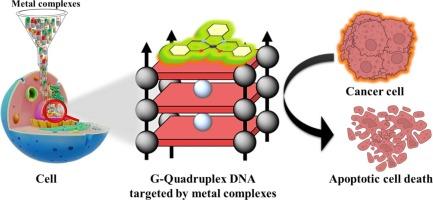Decoding the prospective of metal complexes in anti-cancer therapeutics by targeting of G-quadruplex DNA
IF 3.2
2区 化学
Q2 BIOCHEMISTRY & MOLECULAR BIOLOGY
引用次数: 0
Abstract
The use of metallodrugs in cancer therapy received widespread interest after the successful application of cisplatin and its analogous compounds as chemotherapeutic medications. Despite the development of various metallodrugs in past years, platinum-based chemotherapeutic agents are the only clinically approved metallodrugs that primarily interact with genomic DNA and trigger severe dose-limiting adverse side effects in cancer patients. As a consequence, the advancement of new risk-free metallodrugs has become a topmost concern in cancer research to minimize toxicity and improve therapeutic outcomes. G-quadruplex (G4) DNA structures have recently come to light as an attractive drug target in cancer therapy because of their gene regulation ability and role in maintaining genomic stability. Their presence in telomere and promoter region of oncogenes has the potential to induce apoptosis in cancer cells through the inhibition of telomerase activity and gene expression. Therefore, the development of new G4 DNA targeting small molecular entities including metal complexes came out as a viable approach for uprooting cancer disease. Beyond organic small molecules, innumerable metal complexes have been developed in past years to target G4 DNA structures in the context of cancer therapy. This review primarily aims to highlight these metal complexes through a comprehensive discussion about their structural properties, their binding interactions with G4 DNA, their cancer cell growth inhibition mechanisms, and their efficacy in both cellular and in vivo systems, to decode their potential as anti-cancer drugs. Additionally, the potential of these metal complexes in the field of bio-imaging and photodynamic therapy is also explored.

以g -四重体DNA为靶点解读金属配合物抗癌治疗的前景
在顺铂及其类似化合物成功应用于化疗药物后,金属药物在癌症治疗中的应用受到了广泛的关注。尽管近年来开发了各种金属药物,但铂类化疗药物是唯一临床批准的主要与基因组DNA相互作用并在癌症患者中引发严重剂量限制性不良副作用的金属药物。因此,新型无风险金属药物的发展已成为癌症研究中最受关注的问题,以减少毒性和改善治疗效果。g -四重体(G4) DNA结构由于其基因调控能力和维持基因组稳定性的作用,最近成为癌症治疗中一个有吸引力的药物靶点。它们存在于癌基因的端粒和启动子区,有可能通过抑制端粒酶活性和基因表达来诱导癌细胞凋亡。因此,开发新的G4 DNA靶向小分子实体,包括金属配合物,成为根除癌症疾病的可行方法。除了有机小分子外,在过去的几年里,无数的金属配合物已经被开发出来,在癌症治疗的背景下靶向G4 DNA结构。本文旨在通过对这些金属配合物的结构特性、与G4 DNA的结合相互作用、癌细胞生长抑制机制及其在细胞和体内系统中的功效的全面讨论,来揭示它们作为抗癌药物的潜力。此外,还探讨了这些金属配合物在生物成像和光动力治疗领域的潜力。
本文章由计算机程序翻译,如有差异,请以英文原文为准。
求助全文
约1分钟内获得全文
求助全文
来源期刊

Journal of Inorganic Biochemistry
生物-生化与分子生物学
CiteScore
7.00
自引率
10.30%
发文量
336
审稿时长
41 days
期刊介绍:
The Journal of Inorganic Biochemistry is an established international forum for research in all aspects of Biological Inorganic Chemistry. Original papers of a high scientific level are published in the form of Articles (full length papers), Short Communications, Focused Reviews and Bioinorganic Methods. Topics include: the chemistry, structure and function of metalloenzymes; the interaction of inorganic ions and molecules with proteins and nucleic acids; the synthesis and properties of coordination complexes of biological interest including both structural and functional model systems; the function of metal- containing systems in the regulation of gene expression; the role of metals in medicine; the application of spectroscopic methods to determine the structure of metallobiomolecules; the preparation and characterization of metal-based biomaterials; and related systems. The emphasis of the Journal is on the structure and mechanism of action of metallobiomolecules.
 求助内容:
求助内容: 应助结果提醒方式:
应助结果提醒方式:


